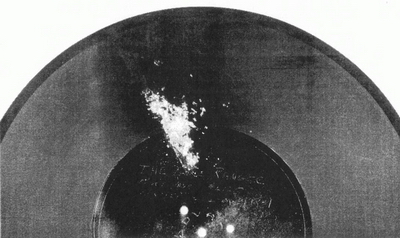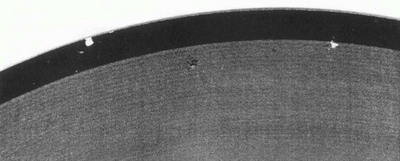|
Acetate Phonograph Recordings: Preservation, Storage and Playback
by Graham Newton
The coating on
this
"acetate" has
been
destroyed by
corrosion
of the
aluminum
base
that got started
from a chip or
crack.
Poor storage conditions
and moisture
may have accelerated the damage to the point
where it likely is
not recoverable.

|
|
Before the introduction of magnetic tape, radio shows
and most recordings intended for broadcast were made on acetate coated discs called "soft cuts" or "instantaneous" discs, or simply "acetates".
Most often these were on an aluminum base, but during wartime, many were made with a glass base and
were, as a result, extremely fragile, and usually marked
as such.
In the case of phonograph records intended for
mass distribution, they were plated and metal "stampers"
were made from which multiple pressings were produced...the common 78s that we are all familiar with.
Where discs were not intended for more than a
few plays, the "acetate" disc was ideal, although they
were not as durable as a shellac disc and were easily
scratched or otherwise audibly damaged. They were
available in the common sizes of 10" and 12" in diameter, but a 16" version was more commonly used for
recording radio program material, since they could
record over 15 minutes per side at 33-1/3 RPM. A complete show usually was recorded over two separate discs
to allow "cueing" the second part of the program for
"seamless" playback. Often two separate half-hour
shows were contained on the two discs to simplify distribution to the stations. Where masters were required
for pressing, an even larger disc of 17-1/4" was used to
provide a gripping edge for the equipment that would
handle it during manufacture.
To preserve acetates for a long period, they require
a little more care than a vinyl or shellac phonograph
record. Often they were not given the best of care and
many suffer from "cold flow" damage, caused by being
piled on top of each other and stored under improper
conditions, often in unheated areas where temperature
extremes allowed them to freeze and thaw many times
during a winter, and summer temperatures could rise
to well over 120 degrees. Surface pitting, scratching,
chipping, corrosion and other problems all add up to
clicks and pops and swishing noises during playback,
although for the most part these problems occur near
the edges of the discs.
The freezing and thawing causes the acetate to
"effloresce", releasing some of its component ingredients
in the form of a grayish, greasy, powdery substance
that coats the surface and must be removed before any
attempts to play the disc. Start with washing the disc
in luke warm water with a non-abrasive dish-washing
detergent and carefully rinsing and drying, followed
by wiping with a folded paper towel pad lightly wetted
with household lighter fluid or a dry cleaning solution
called perchloroethylene. Wipe with the grooves, never
across them, and wipe dry. You may notice a light
bluish tinge on the paper towel, particularly if you use
perchloroethylene...it is the dissolved efflorescence
along with some surface material that you are removing.
(It is recommended that you wear latex gloves while
doing this to protect your hands since both are powerful solvents and will remove skin oils, and this should
be done in a well ventilated area with no open flames
or other sources
of sparks or fire.)
The chip in the coating of this
"acetate" is
near the edge of the
disc and goes down to
the aluminum
base
and spans 11 grooves.
Although it looks bad,
it can be tracked with
the appropriate cartridge and stylus.

|
|
Where poor storage conditions are not an issue,
cleaning an acetate disc for playback is easy, assuming
that it has been stored carefully in an environment
that humans would be relatively comfortable with.
Just luke-warm water with a little non-abrasive dish-
washing detergent is enough to get accumulated dirt
out, and rinse it well to remove any detergent residue.
(And remember to always wipe with the grooves,
never across them.) A small velvet pad can be used to
dry-wipe with the grooves to pick up accumulated dust.
Sometimes a light spray of distilled water along with
wiping will keep dust and static accumulation down.
Store "acetates" only in a vertical position, never
stack on top of each other. Acetate discs are very heavy
and the weight, under certain conditions, can cause
the "cold flow" damage already mentioned. The relatively soft acetate is distorted by the weight of the
discs stacked above them. You may be able to see just
such damage on the outside grooves of some discs,
caused by the flap of the protective storage envelope
being "pressed" into the disc, distorting the surface
near the edge, causing a "swishing" noise when played.
This noise will be more or less proportional to the
amount of "cold flow" that occurred and it cannot be
repaired or removed...itís as though it was there at the
time of recording.
Play "acetates" with a 2.5 or 3 mil standard stylus.
Although you can use a stylus intended for LP records
ó and that includes .5 mil, .7 mil and 1 mil styli ó
these are mostly too small and ride the bottom of the
grooves, often producing a lot of noise and much
lower output than the recommended styli. If you are
playing "acetates" with a stereo cartridge using the
recommended 2.5 or 3 mil stylus, you will often find
that playing only from the left channel provides lower
noise than either the right channel or both channels
played simultaneously.
When you care for an acetate disc as described
above,it will last for an undetermined length of
time. The writer has acetate discs, cut well over 50
years ago, that play as well today as when they were
first cut, and perhaps better, since modern playback
equipment can get more out of the grooves than the
best equipment available at the time the recordings
were originally made.
|